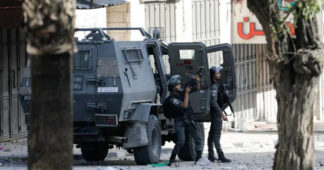By Andre Damon
Dec 12, 2023
As Israel continues its bombing, starvation and ethnic cleansing of the people of Gaza, hunger has reached epidemic proportions. Nine in 10 people in Gaza reported going to bed hungry, the United Nations’ World Food Program reported.
More than half of the population—over 63 percent—reported going for days without food. “Hunger stalks everyone,” UNRWA (United Nations Relief and Works Agency for Palestine), the United Nations body responsible for Palestinian refugees, wrote in a statement on Twitter. “Too many people haven’t eaten now for two, three days in the Gaza Strip.”
UN Special Rapporteur on Food Michael Fakhri told Al Jazeera Arabic, “Every single Palestinian in Gaza is going hungry,” in an interview, in which he identified the mass murder of the population of Gaza as “genocide.”
These reports follow a veto Friday by the United States of a UN resolution calling for a ceasefire. This week, a non-binding ceasefire resolution is expected to pass the United Nations General Assembly. The United States, meanwhile, doubled down on calling for a “military” solution to the crisis, in an open endorsement of the genocide.
“We think there can be a military solution to taking out the leadership of Hamas that planned and carried out the attacks of October 7, in taking out the militants who crossed into Israel and carried out those attacks,” US State Department spokesperson Matthew Miller said in a briefing.
This followed the statement Sunday by US Secretary of State Antony Blinken: “When it comes to a ceasefire in this moment, with Hamas still alive, still intact, and again, with the stated intent of repeating October 7th again and again and again, that would simply perpetuate the problem.”
On Monday, the Washington Post reported that Israel used US-supplied white phosphorus munitions to carry out attacks on Lebanon, in violation of international laws prohibiting the use of the incendiary weapon in densely populated areas. For weeks, videos have shown Israel raining down white phosphorus on populated areas. The report follows the announcement Friday by the White House that it would bypass congressional authorization to send Israel $100 million worth of tank ammunition.
On Monday, the death toll from the bombardment of the Gaza Strip surged to 18,205, with roughly another 7,000 still missing and likely buried under the rubble. The Palestinian Health Ministry warned that it is following 325,000 cases of infectious diseases, meaning that one in six people in Gaza are ill with such a disease, amid the dismantling of all infrastructure to support life.
Nicholas Papachrysostomou, the emergency coordinator in Gaza for Doctors Without Borders, told Al Jazeera, “every other patient in Rafah has a respiratory infection, amid rainy and cold conditions. In some shelters, 600 people share a single toilet. We are already seeing many cases of diarrhea. Often children are the worst affected,” he said.
The United Nations reported, “on 11 December, the maternity department at Kamal Adwan hospital in Beit Lahiya, north of Gaza, was hit. As a result, two mothers were reportedly killed, and several people were injured.”
The World Health Organization Executive Board issued a statement warning of a total breakdown of Gaza’s healthcare system. “Gaza’s health system is on its knees and collapsing, with the risk expected to worsen with the deteriorating situation and approaching winter conditions,” said the WHO’s director-general.
“As more and more people move to a smaller and smaller area, overcrowding, combined with the lack of adequate food, water, shelter and sanitation, are creating the ideal conditions for disease to spread,” he added.
The UN reported: “in the north and Gaza City, Israeli forces reportedly detained hundreds of men and boys staying in public spaces, schools serving as shelters for internally displaced persons (IDPs) as well as private homes. Reportedly, detainees were stripped to their underwear, handcuffed, and were ordered to sit on their knees in open areas, subjected to beatings, harassment, harsh weather, and denial of basic necessities.”
In a statement, Omar Shakir, the Israel and Palestine director at Human Rights Watch, condemned this flagrant war crime. “The Israeli army’s publication of shocking photos of detained Palestinian men in Gaza stripped & blindfolded constitutes ‘outrages upon personal dignity’—a form of inhumane treatment that amounts to a war crime,” Shakir wrote on Monday. “Perpetrators should be held to account.”
To date, 81 Palestinian journalists have been killed in Israeli airstrikes since October 7, and 296 medical workers have been killed. On Monday, Al Jazeera journalist Anas al-Sharif was targeted in a bombing of his home in northern Gaza’s Jabaliya refugee camp, which killed his father. Al Jazeera said the murder came “after a series of threats received by [al-Sharif] last November in an attempt to deter him from carrying out his duty.”
The Committee to Protect Journalists responded to the attack by declaring it was “deeply alarmed by the pattern of journalists in Gaza reporting receiving threats, and subsequently, their family members being killed.” It added, “The killing of the family members of journalists in Gaza is making it almost impossible for the journalists to continue reporting, as the risk now extends beyond them also to include their beloved ones.”
Israel’s mass murder is accompanied by mass displacement. After ordering the entire population to evacuate from northern Gaza, a further 30 percent of southern Gaza has been marked for compulsory evacuation by the Israeli military. Hundreds of thousands of people are being crammed further and further south, huddled in squalid refugee camps near the Rafah border crossing with Egypt, through which Israeli politicians have called for Gazans to be displaced.
We remind our readers that publication of articles on our site does not mean that we agree with what is written. Our policy is to publish anything which we consider of interest, so as to assist our readers in forming their opinions. Sometimes we even publish articles with which we totally disagree, since we believe it is important for our readers to be informed on as wide a spectrum of views as possible.











